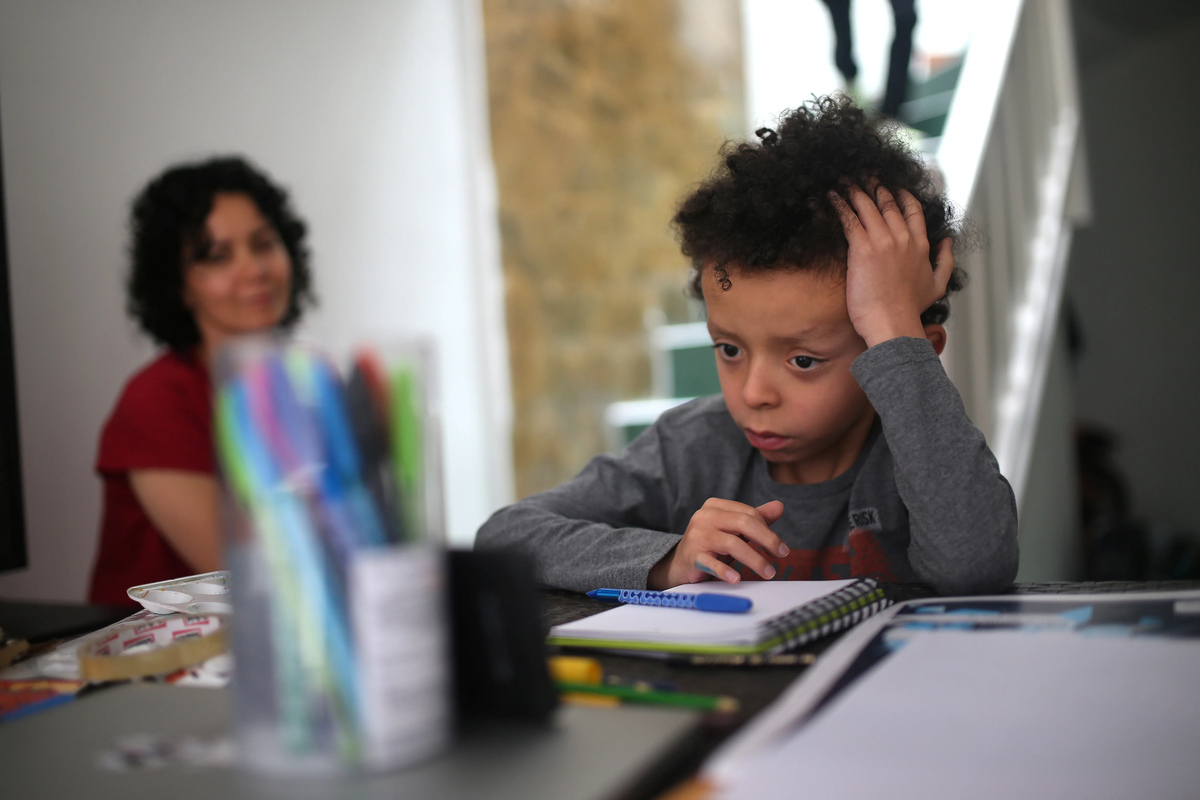Home>Health & Lifestyle>Family & Pet-Friendly Home Design>How To Help Students With A Bad Home Life


Family & Pet-Friendly Home Design
How To Help Students With A Bad Home Life
Published: December 22, 2023
Discover effective strategies for supporting students dealing with a challenging home life. Explore family and pet-friendly home design ideas to create a nurturing environment for learning.
(Many of the links in this article redirect to a specific reviewed product. Your purchase of these products through affiliate links helps to generate commission for Storables.com, at no extra cost. Learn more)
Introduction
Welcome to the often-uncharted territory of understanding and supporting students with a challenging home life. The impact of a tumultuous home environment on a student’s well-being and academic performance cannot be overstated. As educators, it is essential to recognize the profound influence that a student’s home life can have on their overall success and happiness. By acknowledging and addressing these challenges, we can create a supportive and nurturing environment within the classroom, providing students with the tools and resources they need to thrive despite their circumstances.
In this comprehensive guide, we will delve into the multifaceted ways in which a difficult home life can affect students and explore strategies for creating a positive and empowering classroom environment. From providing emotional support to connecting students with resources and collaborating with external support services, we will explore a range of proactive approaches to help students navigate the challenges they may face at home. By fostering a sense of understanding, empathy, and resilience, we can make a meaningful difference in the lives of our students, empowering them to overcome obstacles and reach their full potential.
Key Takeaways:
- Students facing challenges at home need understanding and support from teachers to thrive academically and emotionally, creating a safe and inclusive classroom environment is crucial for their success.
- Educators should connect students with resources, collaborate with parents, and utilize school and community support services to empower students to overcome adversity and reach their full potential.
Read more: How Home Life Effects Student Performance
Understanding the Impact of a Bad Home Life on Students
For students facing adversity at home, the impact can permeate every aspect of their lives, including their academic performance, emotional well-being, and overall development. A challenging home life can manifest in various forms, such as domestic instability, financial hardship, substance abuse, neglect, or even violence. These circumstances can create a pervasive sense of insecurity and stress, making it difficult for students to focus on their studies and engage positively in the learning process.
Academically, students from troubled homes may struggle with concentration, attendance, and completing assignments. The emotional toll of their home life can lead to feelings of anxiety, low self-esteem, and a lack of motivation. These challenges often translate into a decline in academic performance and a sense of disconnection from the learning environment.
Moreover, the impact of a bad home life extends beyond the classroom, affecting a student’s social interactions, mental health, and long-term prospects. The stress and trauma experienced at home can hinder a student’s ability to form healthy relationships, regulate their emotions, and envision a positive future for themselves. As educators, it is crucial to recognize these far-reaching effects and implement strategies to provide the necessary support and understanding.
By acknowledging the profound impact of a difficult home life on students, we can cultivate a compassionate and empathetic approach to education. Understanding the nuanced challenges that students face outside of school allows us to create a more inclusive and supportive learning environment, fostering resilience and empowering students to overcome obstacles beyond the classroom walls.
Creating a Supportive Classroom Environment
Establishing a supportive classroom environment is paramount in helping students navigate the challenges of a difficult home life. By fostering a sense of safety, trust, and inclusivity, educators can create a space where students feel valued and empowered to learn and grow. Here are several key strategies for creating a nurturing classroom environment:
- Build Trust and Rapport: Cultivate meaningful connections with your students by showing genuine interest in their well-being and creating opportunities for open dialogue. Building trust and rapport can provide students with a sense of security and belonging, which is especially crucial for those facing adversity at home.
- Emphasize Inclusivity: Create a classroom culture that celebrates diversity and inclusivity. Encourage students to share their unique experiences and perspectives, fostering a sense of belonging for all individuals, regardless of their home circumstances.
- Establish Clear Expectations: Set clear and consistent expectations for behavior, academic performance, and mutual respect within the classroom. Predictability and structure can provide a stabilizing influence for students who may lack consistency in their home life.
- Provide Emotional Support: Be attuned to the emotional needs of your students and create space for them to express their feelings in a safe and non-judgmental environment. Offering empathy and understanding can help students feel supported and validated.
- Encourage Collaboration: Foster a collaborative and cooperative learning environment where students can work together, share ideas, and support one another. Collaboration can provide a sense of community and shared responsibility, mitigating the sense of isolation that some students may experience at home.
By implementing these strategies, educators can lay the foundation for a classroom environment that promotes resilience, empathy, and academic success. Creating a supportive and inclusive space within the classroom can serve as a vital source of stability and encouragement for students facing adversity at home, empowering them to thrive despite their challenges.
Providing Emotional Support
Emotional support is a cornerstone of helping students cope with the challenges of a difficult home life. As educators, it is essential to create an environment where students feel emotionally validated, understood, and empowered to navigate their emotions constructively. Here are key strategies for providing emotional support within the classroom:
- Active Listening: Take the time to actively listen to your students without judgment. Validate their feelings and provide a safe space for them to express their emotions openly.
- Empathy and Understanding: Demonstrate empathy and understanding towards your students’ experiences. Acknowledge the difficulties they may face at home and offer reassurance that they are valued and supported in the classroom.
- Encourage Self-Expression: Create opportunities for students to express themselves through writing, art, or open discussions. Allowing for creative self-expression can be therapeutic and empowering for students dealing with emotional challenges.
- Teach Stress-Management Techniques: Introduce stress-management techniques such as deep breathing exercises, mindfulness practices, or other relaxation strategies. Providing students with tools to manage stress can help them cope with the emotional impact of their home life.
- Offer One-on-One Support: Be available for one-on-one conversations with students who may need additional support. Building individual connections can make a significant difference in helping students feel understood and supported.
By prioritizing emotional support within the classroom, educators can create a nurturing and empathetic environment where students feel encouraged to express themselves and seek assistance when needed. Providing emotional support not only validates the experiences of students with a challenging home life but also equips them with the emotional resilience to navigate their circumstances with greater strength and confidence.
Create a safe and supportive environment in the classroom, offer counseling resources, and be a positive role model to help students with a bad home life.
Connecting Students with Resources
Connecting students with resources is a crucial step in providing comprehensive support for those facing challenges at home. By offering access to relevant support services and resources, educators can empower students to address their needs and navigate their circumstances more effectively. Here are key strategies for connecting students with resources:
- Identify Support Networks: Familiarize yourself with the support networks available within the school, community, and beyond. This may include school counselors, mental health professionals, community organizations, and support hotlines.
- Provide Information: Share information about available resources with your students and their families. This may include contact details for counseling services, support groups, financial assistance programs, or other relevant resources in the community.
- Facilitate Referrals: When necessary, facilitate referrals to school counselors or external support services for students who may benefit from additional assistance. Collaborate with relevant professionals to ensure that students receive the support they need.
- Empower Students: Encourage students to take an active role in seeking support by providing them with the knowledge and tools to access resources independently. Empowering students to advocate for themselves can foster a sense of agency and self-efficacy.
- Coordinate with Community Partners: Establish connections with community organizations and support services to create a network of resources for students. Collaborating with external partners can expand the range of support available to students and their families.
By proactively connecting students with resources, educators play a pivotal role in ensuring that students have access to the support they need to navigate the challenges of a difficult home life. By fostering a network of resources and support, educators can empower students to seek assistance, build resilience, and access the necessary tools to thrive academically and emotionally despite their circumstances.
Communicating with Parents and Guardians
Effective communication with parents and guardians is instrumental in creating a holistic support system for students facing challenges at home. By fostering open and collaborative communication, educators can gain valuable insights into students’ home environments and work in partnership with families to provide the necessary support. Here are key strategies for communicating with parents and guardians:
- Establish Open Channels of Communication: Create avenues for regular communication with parents and guardians, such as parent-teacher meetings, email updates, and phone calls. Open channels of communication can facilitate a supportive and collaborative relationship.
- Listen with Empathy: When engaging with parents and guardians, approach conversations with empathy and understanding. Listen attentively to their concerns and perspectives, acknowledging the unique challenges they may be facing within the home environment.
- Share Observations and Concerns: Communicate openly about your observations and concerns regarding a student’s well-being and academic performance. Sharing insights with parents can provide them with a comprehensive understanding of their child’s experiences at school.
- Offer Support and Resources: Provide information about available support services and resources that may benefit the student and their family. This may include counseling services, community programs, or educational support initiatives.
- Collaborate on Support Strategies: Work collaboratively with parents and guardians to develop tailored support strategies that address the unique needs of the student. By involving families in the support process, educators can create a more cohesive and personalized approach.
By prioritizing open and empathetic communication with parents and guardians, educators can forge meaningful partnerships that contribute to the overall well-being and success of students. Collaborative communication ensures that families feel supported and engaged in their child’s educational journey, fostering a sense of shared responsibility and commitment to the student’s growth and development.
Collaborating with School and Community Support Services
Collaborating with school and community support services is essential in creating a comprehensive network of assistance for students grappling with challenges at home. By leveraging the expertise and resources available within the school and the broader community, educators can provide students with a multifaceted support system. Here are key strategies for collaborating with school and community support services:
- Engage School Counselors and Support Staff: Collaborate closely with school counselors and support staff to identify students who may benefit from additional assistance. These professionals can offer valuable insights and guidance in addressing the diverse needs of students.
- Utilize School-Based Programs: Take advantage of school-based programs and initiatives designed to support students’ emotional well-being and academic success. This may include mentoring programs, peer support groups, and extracurricular activities that provide a sense of community and belonging.
- Forge Partnerships with Community Organizations: Establish partnerships with community organizations, mental health agencies, and social services to expand the range of support available to students. Collaborating with external partners can provide students with access to a diverse array of resources and assistance.
- Coordinate Interdisciplinary Support: Foster interdisciplinary collaboration among educators, counselors, and support services to develop holistic support plans for students. By integrating diverse perspectives and expertise, educators can create comprehensive strategies tailored to individual student needs.
- Advocate for Comprehensive Support Systems: Advocate for the development and enhancement of comprehensive support systems within the school and the broader community. By championing the importance of holistic support, educators can contribute to the creation of a nurturing and inclusive environment for all students.
By collaborating with school and community support services, educators can enrich the support network available to students, ensuring that they receive the multifaceted assistance needed to thrive academically and emotionally. By leveraging the collective expertise and resources of various stakeholders, educators can create a robust safety net that empowers students to overcome the challenges of a difficult home life and reach their full potential.
Conclusion
Supporting students with a challenging home life requires a multifaceted and empathetic approach that encompasses emotional support, resource connections, and collaborative partnerships. By understanding the profound impact of a difficult home environment on students, educators can create a nurturing and inclusive classroom environment that empowers students to thrive despite their circumstances. Prioritizing open communication with parents and guardians, collaborating with school and community support services, and fostering a sense of belonging within the classroom are essential components of providing holistic support to students facing adversity at home.
It is crucial for educators to recognize the resilience and potential within each student and to provide the necessary tools and support to help them overcome the obstacles they may encounter at home. By building trust, offering emotional validation, and connecting students with relevant resources, educators can play a pivotal role in shaping a positive and transformative educational experience for students facing challenges at home.
As we continue to navigate the complexities of supporting students with a difficult home life, it is imperative to approach each interaction with empathy, understanding, and a commitment to fostering a supportive and inclusive learning environment. By embracing the unique strengths and needs of each student, educators can make a lasting impact, nurturing resilience and empowering students to overcome adversity and achieve success both academically and personally.
Ultimately, by championing a holistic and compassionate approach to supporting students with a challenging home life, educators can create a profound and enduring impact, equipping students with the resilience and fortitude to navigate their circumstances and reach their full potential.
Frequently Asked Questions about How To Help Students With A Bad Home Life
Was this page helpful?
At Storables.com, we guarantee accurate and reliable information. Our content, validated by Expert Board Contributors, is crafted following stringent Editorial Policies. We're committed to providing you with well-researched, expert-backed insights for all your informational needs.















0 thoughts on “How To Help Students With A Bad Home Life”